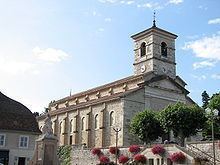Intercommunality Pays des Couleurs Area 32 km² | Population (2010) 5,430 | |
 | ||
Les Avenières is a former commune in the Isère department in the Rhône-Alpes region of south-eastern France. On 1 January 2016, it was merged into the new commune of Les Avenières-Veyrins-Thuellin.
Contents
- Map of 38630 Les AveniC3A8res France
- Geography
- Toponymy
- Prehistory
- Roman Era
- From the Middle Ages to modern times
- 20th Century
- Administration
- Demography
- Civil heritage
- Religious heritage
- Environmental heritage
- References
Map of 38630 Les Aveni%C3%A8res, France
The inhabitants of the commune are known as Avenièrants or Avenièrantes.
Geography
Les Avenières lies on the left bank of the Rhône as it loops north some 25 km east by north-east of Bourgoin-Jallieu and 25 km west by north-west of Chambéry. The Rhone river forms the north-eastern border of the commune and is also the border between Isère and Ain departments. Access to the commune is by road D450 from Veyrins-Thuellin in the south-west which goes to the village then continues south-east to Saint-Genix-sur-Guiers. The D33 goes from Morestel in the north-west and passes through the north of the commune and across the Rhône bridge where it becomes the D10 and goes north-east to join the D19. The D40B goes north from the village to join the D33. The D40E connects the D40 at the eastern edge of the commune to the D40B. Apart from the village there are the hamlets of Le Chamolay, Curtille, Le Grand Chaffard, Le Maitre, Le Bessey, Le Sablonnet, and Les Nappes. The commune has a large forest in the north-east on the Île Molettes with a large urban area in the centre mixed with farmland, and in the south mixed forest and farmland.
The north-western border of the commune consists entirely of a left branch of the Rhône river as it loops north on its course through Lyon south to the Mediterranean. The Grand Canal de l'Huert forms the south-western border of the commune which curves to join the Huert river which is part of the northern border of the commune. The Canal du Champ forms the southern border of the commune where it connects the Grand Canal de l'Huert to the Bièvre river which forms the south-eastern border of the commune flowing north-east to join the Rhône.
Toponymy
The name Avenières is derived from the Franco-Provençal avena meaning "oats".
Prehistory
From the late Neolithic to the middle Bronze Age the region was inhabited by farmers. A scythe found in Les Avenières region is preserved in the Vienne Museum. It is the only evidence of human occupation before the Gallo-Romans. It was found at the confluence of the Bièvre and the Rhône.
Roman Era
In 1989 maintenance work undertaken in the La Cour du Pont district led to the discovery of two oak piles at a depth of 2 metres. A Carbon-14 study undertaken by the centre for chronology at the Claude Bernard University Lyon 1 (CNRS) gave a date between 39 BC and 120 AD. It is possible that they were piles for a Gallo-Roman bridge used to cross the Rhone between Les Avenières and Thuellin.
From the Middle Ages to modern times
20th Century
At the beginning of the 20th century the town was served two secondary railways: the Chemin de fer de l'Est de Lyon to Lyon and Aosta, and the Tramways départementaux de l'Isère, which was taken over by Tramways de l'Ouest du Dauphiné, to La Tour-du-Pin. This last operated from 1909 to 1935.
Administration
List of Successive Mayors
(Not all data is known)
Demography
In 2010 the commune had 5,430 inhabitants. The evolution of the number of inhabitants is known from the population censuses conducted in the commune since 1793. From the 21st century, a census of communes with fewer than 10,000 inhabitants is held every five years, unlike larger communes that have a sample survey every year.
Sources : Ldh/EHESS/Cassini until 1962, INSEE database from 1968 (population without double counting and municipal population from 2006)
